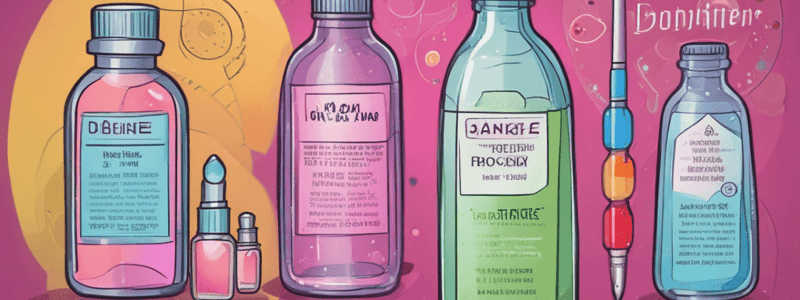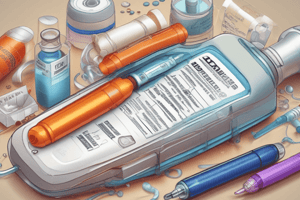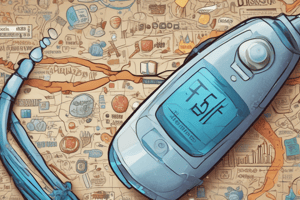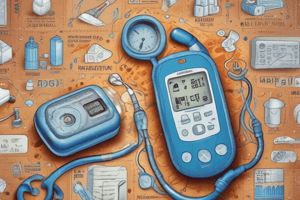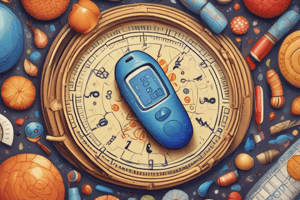Podcast
Questions and Answers
What is the primary goal of adapting insulin dosing based on the time-action profile?
What is the primary goal of adapting insulin dosing based on the time-action profile?
- To prioritize the type of insulin used over the timing of administration
- To ensure the same glucose control for all patients
- To optimize glucose control and minimize adverse effects (correct)
- To match endogenous insulin secretion precisely
What is the main difference between type 1 and type 2 diabetes patients regarding insulin therapy?
What is the main difference between type 1 and type 2 diabetes patients regarding insulin therapy?
- Type 1 patients require exogenous insulin for survival, while type 2 patients may initially tolerate oral agents (correct)
- Type 1 patients require more frequent insulin doses
- Type 2 patients require more advanced insulin regimens
- Type 2 patients require more types of insulin
What is the limitation of insulin regimens in achieving optimal glucose control?
What is the limitation of insulin regimens in achieving optimal glucose control?
- Insulin regimens are too complex for patients to follow
- Insulin regimens are not effective for type 2 diabetes patients
- Insulin regimens are not tailored to individual patient needs
- It is not yet possible to match exogenous insulin delivery as precisely as endogenous insulin secretion (correct)
What is the purpose of understanding insulin regimen-dependent and regimen-independent factors?
What is the purpose of understanding insulin regimen-dependent and regimen-independent factors?
What is the ultimate goal of insulin therapy?
What is the ultimate goal of insulin therapy?
What is the significance of the time-action profile in insulin therapy?
What is the significance of the time-action profile in insulin therapy?
What is a key factor in determining insulin requirements for patients with type 2 diabetes?
What is a key factor in determining insulin requirements for patients with type 2 diabetes?
Why may patients with severe hyperglycemia need an extra 30% of the insulin dose?
Why may patients with severe hyperglycemia need an extra 30% of the insulin dose?
What is an important factor to consider when formulating insulin dosing regimens for patients with type 2 diabetes?
What is an important factor to consider when formulating insulin dosing regimens for patients with type 2 diabetes?
What is the purpose of documenting the time of the meal, carb content of the food, and corresponding blood sugar and insulin dose?
What is the purpose of documenting the time of the meal, carb content of the food, and corresponding blood sugar and insulin dose?
What may happen if a patient starts a new exercise regime without adjusting their insulin dose?
What may happen if a patient starts a new exercise regime without adjusting their insulin dose?
What is a potential consequence of reducing insulin dose by 20% in patients with increased insulin sensitivity?
What is a potential consequence of reducing insulin dose by 20% in patients with increased insulin sensitivity?
Why may insulin dose need to be increased gradually when stopping exercise?
Why may insulin dose need to be increased gradually when stopping exercise?
What is the primary goal of adjusting insulin dosing based on various factors?
What is the primary goal of adjusting insulin dosing based on various factors?
What type of exercise is likely to increase the risk of hypoglycemia when performed during a time of active insulin and low levels of circulating glucose?
What type of exercise is likely to increase the risk of hypoglycemia when performed during a time of active insulin and low levels of circulating glucose?
What is a common challenge in insulin therapy for overweight type 2 patients in community practice settings?
What is a common challenge in insulin therapy for overweight type 2 patients in community practice settings?
Flashcards are hidden until you start studying
